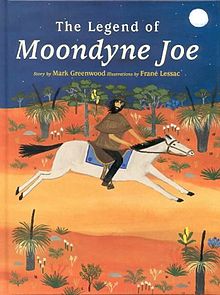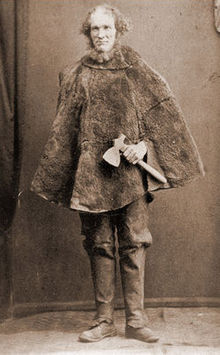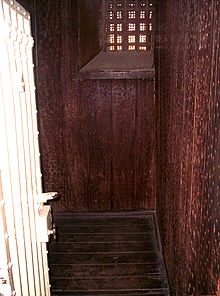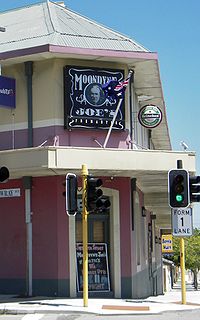- Moondyne Joe
-
Joseph Bolitho Johns (c. 1826–August 13, 1900), better known as Moondyne Joe, was Western Australia's best known bushranger.
Contents
Biography
Little is known of Joseph Johns's early life. Born in Cornwall, England around 1826 and raised as a Roman Catholic, he was the third of six children of blacksmith Thomas Johns and his wife Mary. It is likely that he contracted smallpox in his youth, as later records describe him as "pockmarked". His father died some time between 1832 and 1841, and Johns and his three brothers took work as copper miners. In 1841 the family was living at Illogan, Cornwall, but by 1848 Johns had migrated to Wales, taking work as an iron ore miner, probably at the Clydach Iron Works.[1]
On 15 November 1848, Johns and an associate named John Williams were arrested near Chepstow for "... stealing from the house of Richard Price, three loaves of bread, one piece of bacon, several cheeses, and other goods".[2] Arraigned at the Brecon Assizes on charges of burglary and stealing, the pair pleaded not guilty. On 23 March they were tried at the Lent Assizes before Sir William Erle. Newspaper reports of the trial suggest that the pair gave an unexpectedly spirited defence, but Johns was abrasive and "contravened the conventions of court procedure". The men were convicted and sentenced to ten years' penal servitude. Edgar (1990) observes that in several other cases brought before the same judge that day, guilty pleas to very similar charges resulted in sentences ranging from three weeks to three months.[3]
Johns and Williams would have spent the next seven months working on a government work party in the local area, before being transferred to Millbank Prison. On 1 January 1850, they were transferred to Pentonville Prison to serve their mandatory six months of solitary confinement. The pair were transferred to Dartmoor Prison on 21 October 1851, but shortly afterwards Johns was transferred to the Woolwich prison hulk Justitia, probably for disciplinary reasons. When the Justitia was destroyed by fire, he was transferred to the Defence. About a year later, he boarded the Pyrenees for transportation to what was then the British penal colony of Western Australia.[3]
The Pyrenees sailed for Western Australia on 2 February 1853, and arrived in Fremantle on 30 April. In reward for good behaviour, Johns was issued with a ticket of leave on arrival, and on 10 March 1855 he received a conditional pardon. He then settled in the Avon Valley, one of the most rugged and inaccessible places in the Darling Range. The Aboriginal name for the area was Moondyne. Johns made a living by partly fencing the springs in the area, and trapping escaped stock and horses. Often a reward was offered for the return of such animals.[3]
In August 1861, Johns caught an unbranded stallion, and branded it with his own mark. This was effectively horse-stealing, and when the police heard of this they arrested him at their first opportunity. The horse was taken as evidence, and Johns was placed in the Toodyay lockup. Sometime during the night, Johns broke out of his cell, and stole the horse once more, taking also the local magistrate's brand new saddle and bridle. He was caught the next day, but while on the run he had killed the horse and cut his brand out of the hide, thus destroying the evidence. Consequently, he received only a three year sentence for jail-breaking, whereas a typical sentence for horse stealing was more than ten years.[4]
While Johns was serving his sentence, there were a rash of convict escapes and attempted escapes, but Johns remained well behaved. His good behaviour earned him a remission on his sentence, and he was released on a ticket of leave in February 1864. He then found work on a farm in Kelmscott, but in January 1865 a neighbour's steer was killed and eaten, and Johns was accused of having done the deed. Johns was to protest his innocence of this crime for the rest of his life, but was nonetheless found guilty and sentenced to ten years' penal servitude. Johns was determined not to serve what he felt was an unjust sentence, and in early November he and another prisoner absconded from a work party. They were on the run for nearly a month, during which time they committed a number of small robberies. It was during this time that Johns first adopted the nickname Moondyne Joe. They were finally caught 37 kilometres east of York by a party of policemen that included the Aboriginal tracker Tommy Windich. For absconding and for being in possession of a firearm, Moondyne Joe was sentenced to twelve months in irons.[4]
In April 1865, Joe sent a petition to the Chief Justice, and received four years off his sentence. This was apparently unsatisfactory to him, for later that month he received a further six months in irons for trying to cut the lock out of his door. Early in August, he succeeded in escaping again. After cutting off his irons, he met up with three other escapees, and together they roamed the bush around Perth, committing a number of robberies and narrowly escaping capture on a number of occasions. Near the end of the month, one of the gang was captured by police. Realising that the gang could not elude the police forever, Moondyne Joe formulated a plan to escape the colony by travelling overland to the colony of South Australia. This would be a long and arduous journey through extremely arid land, and would have to be very well equipped if it were to stand any chance of success. On 5 September Moondyne Joe equipped his company by committing the biggest robbery of his career, stealing supplies and equipment from the Toodyay store of an old enemy, James Everett. The gang then started travelling east along the explorer Charles Hunt's established route. Their tracks were discovered by police on 26 September, about 160 kilometres east of York. A team of police then set out after them, and they were captured on 29 September near the present-day site of the town of Westonia, about 300 kilometres north east of Perth.[4]
As punishment for escaping and for the robberies committed while on the run, Moondyne Joe received five years hard labour on top of his remaining sentence. Extraordinary measures were taken to ensure that Johns did not escape again. He was transferred to Fremantle Prison where a special "escape-proof" cell was made for him built from stone, lined with jarrah sleepers and over 1000 nails. He was set to work breaking stone, but rather than permit him to leave the prison, the stone was brought in and dumped in a corner of the prison yard, where Johns worked under the constant supervision of a warder. Governor John Hampton was so confident of the arrangements, he was heard to say to Johns: "If you get out again, I'll forgive you". However, the rock broken by Joe was not removed regularly, and eventually a pile grew up until it obscured the guard's view of Joe below the waist. Partially hidden behind the pile of rocks, he occasionally swung his sledgehammer at the limestone wall of the prison. On 7 March 1867, Moondyne Joe escaped through a hole he had made in the prison wall. Despite an extensive manhunt, no sign of him was found, and he would not be recaptured for nearly two years. He did not return to any of his old haunts, and he committed no crimes, so the authorities received very little information about him. Also, many convicts were encouraged by Moondyne Joe's audacious escape, and a number of escapes were attempted in the following months, so that he was quickly forgotten.[4]
A few days before the second anniversary of his escape, Moondyne Joe tried to steal some wine from the cellars at Houghton Winery. By chance, the owner had been helping with a police search, and afterwards invited a group of police back to the vineyard for refreshments. When the owner entered the cellar, Joe assumed that he was discovered, and made a dash for the door into the arms of the police. He was returned to prison, and on 22 March 1869 was sentenced to an additional four years in irons. He made at least one more attempt to escape, but was unsuccessful. Eventually, Governor Weld heard of his predecessor Hampton's promise, and decided that further punishment would be unfair. Moondyne Joe was given a ticket of leave in April 1871.[4]
The remainder of John's life consisted of periods of good behaviour punctuated by occasional minor misdemeanors and brief jail terms. In January 1879, he married a widow named Louisa Hearn, and they spent some time prospecting for gold near Southern Cross. In 1881, while exploring the countryside around Karridale, he discovered Moondyne Cave. In his later years, he began acting strangely, and was eventually found to be mentally ill. He died of senile dementia in the Fremantle Lunatic Asylum (now the Fremantle Arts Centre building) on 13 August 1900, and was buried in Fremantle Cemetery.[4]
On the first Sunday of May, the township of Toodyay celebrates the life and times of Moondyne Joe by holding the Moondyne Festival.[5] This festival takes place in the main street and has street theatre, market stalls, demonstrations and the entire town is generally transported back to the early years. The most recent Moondyne Festival was on 1 May 2011.
Cultural references
Literature and film
 Mark Greenwood's work of juvenile fiction The Legend of Moondyne Joe won the award for Children's Books in the 2002 Western Australian Premier's Book Awards.
Mark Greenwood's work of juvenile fiction The Legend of Moondyne Joe won the award for Children's Books in the 2002 Western Australian Premier's Book Awards.
While Moondyne Joe was bushranging in 1869, an Irish political prisoner named John Boyle O'Reilly was serving time in Fremantle Prison. Although it is very unlikely that O'Reilly knew Moondyne Joe, he must have heard many stories of Joe's exploits. In September 1869, O'Reilly escaped and was rescued by an American ship. After his arrival in the United States, he wrote a novel about convict life called Moondyne: An Australian Tale, whose central character was called Moondyne Joe. The book is presented as fiction, and neither the character nor the plot bears much resemblance to the life of Joseph Johns.
In 1913, O'Reilly's novel was made into a movie entitled Moondyne.[6] Directed by W. J. Lincoln, it starred George Bryant, Godfrey Cass and Roy Redgrave.[7]
Randolph Stow wrote a humorous children's book Midnite: The Story of a Wild Colonial Boy in 1967 which told the story of an Australian bushranger based on the life and exploits of Moondyne Joe and a Queensland bushranger Captain Starlight.[8]
In 2002, Cygnet Books published The Legend of Moondyne Joe, a work of juvenile fiction written by Mark Greenwood and illustrated by Frané Lessac.[9] The book won the award in the Children's Books category at the 2002 Western Australian Premier's Book Awards.
In song and verse
The Ballad of Moondyne Joe[10]
- In the Darling Ranges, many years ago,
- There lived a daring outlaw, by the name of ‘Moondyne Joe’.
- He stole the squatter’s horses, and a sheep or two or three,
- He loved to roam the countryside, and swore he would be free.
- The troopers said we’ll catch him, but we know it’s all in vain,
- Every time we lock him up he breaks right out again.
- ‘Cause in he goes, and out he goes, and off again he’ll go,
- There’s not a gaol in W.A. can keep in ‘Moondyne Joe’.
Anonymous - sung by the public at the time of his 1867 escape[11]
- The Governor's son has got the pip,
- The Governor's got the measles.
- For Moondyne Joe has give 'em the slip,
- Pop goes the weasel.
Anonymous[12]
- It were Moondyne of course
- That took Ferguson's horse.
- He'd hidden the same
- In the hills of that name.
- When he found it had gone
- Ferguson searched all the Swan,
- And offered a pound
- For when it was found.
- But Joe has it hid
- And he pockets the quid.
- In a month to the day
- Again the horse goes astray.
- But Ferguson's no fool
- Goes along to Moondyne Pool.
- To see if it's true
- The police comes too.
- When his sentence is gone
- Joe is done with the Swan.
- They call me bushranger—
- I'll feel quite a stranger;
- So by the Mass
- I'll try the Vasse.
- At Ellensbrook
- The silly old rook
- Gets a job
- At Fifteen Bob.
- No more I don't know
- That's the story of Moondyne Joe.
Memorials
A railway siding on the Eastern Goldfields Railway in Johns' area of operations in the Avon Valley has been named 'Moondyne', most likely after the man rather than the area.
See also
- List of convict ship voyages to Western Australia
- Convicts transported to Western Australia include:
- Cornish Australian
References
- ^ Devereux, Drew (2006). "Early life of Moondyne Joe". Dollypot, Greenhide and Spindrift: a journal of bush history 2 (3). ISBN 0859054160. Archived from the original on 27 September 2007. http://web.archive.org/web/20070927062004/http://www.hesperianpress.com/dollypot_greenhide/Vol2_no3.htm. Retrieved 22 November 2006.
- ^ "Breconshire Lent Assizes". The Welshman: pp. 1849–03–30.
- ^ a b c Edgar, W. J. (1990). The Life and Times of Moondyne Joe: Swan River Colony Convict Joseph Bolitho Johns. Toodyay, Western Australia: Tammar Publications and Toodyay Tourist Centre. ISBN 0-646-00047-0.
- ^ a b c d e f Elliot, Ian (1978). Moondyne Joe: The Man and the Myth. Nedlands, Western Australia: University of Western Australia Press. ISBN 0-85564-130-4. Republished in 1998 by Carlisle, Western Australia: Hesperian Press. ISBN 0-85905-244-3.
- ^ "Toodyay’s Moondyne Festival". moondynefestival.com. http://moondynefestival.com/. Retrieved 1 March 2009.
- ^ Routt, William D. (2002). "More Australian than Aristotelian: The Australian Bushranger Film, 1904–1914". Senses of Cinema (18). http://archive.sensesofcinema.com/contents/01/18/oz_western.html.[dead link]
- ^ "Moondyne (1913)". IMDb: The Internet Movie Database. http://www.imdb.com/title/tt0193331/. Retrieved 29 May 2006.
- ^ Stowe, Randolph (1969). Midnite: The Story of a Wild Colonial Boy. Puffin Books. ISBN 0-14-030421-5.
- ^ Greenwood, Mark (2002). The Legend of Moondyne Joe. Crawley, Western Australia: Cygnet Books. ISBN 1876268700.
- ^ "Fremantle Prison: Factsheet". http://www.deh.gov.au/heritage/national/sites/fremantle-factsheet.html. Retrieved 14 January 2006.[dead link]
- ^ Graham Seal (1996). The Outlaw Legend: A Cultural Tradition in Britain, America and Australia. Cambridge University Press. ISBN 0521553172.
- ^ Stewart, Athole (25 June 1948). "Western Sussex". Early Days, W.A. Historical Society (December 1948): 37.
External links
- Johns, Joseph Bolitho (1827? - 1900) M. Tamblyn, Australian Dictionary of Biography, Online Edition
Crime in Australia States Cities Towns Crime dynamics Law enforcement Prisons by state Crime internationally Crime by countryCategories:- 1826 births
- 1900 deaths
- Burials at Fremantle Cemetery
- Bushrangers
- Convicts transported to Western Australia
- British escapees
- Escapees from British detention
- Australian escapees
- Australian folklore
- History of Western Australia
- People from Illogan
- Australian people of Cornish descent
- Cornish emigrants to Australia
- Australian miners
- Escapees from Western Australian detention
- Deaths from dementia
Wikimedia Foundation. 2010.



